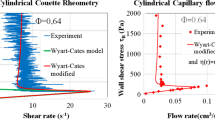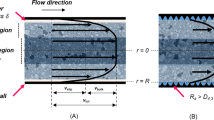Abstract
Impact of wall slip on the yield stress measurement is examined for capillary suspensions consisting of cocoa powder as the dispersed phase, vegetable oil as the continuous primary fluid, and water as the secondary fluid using smooth and serrated parallel plates. Using dynamic oscillatory measurements, we investigated the yielding behavior of this ternary solid-fluid-fluid system with varying particle volume fraction, ϕ, from 0.45 to 0.65 and varying water volume fraction, ϕw, from 0.02 to 0.08. Yield stress is defined as the maximum in the elastic stress (G′γ), which is obtained by plotting the product of elastic modulus (G′) and strain amplitude (γ) as a function of applied strain amplitude. With serrated plates, which offer minimal slippage, capillary suspensions with ϕ ≥ 0.45 and a fixed ϕw = 0.06 showed a two-step yielding behavior as indicated by two peaks in the plots of elastic stress as a function of strain amplitude. On the other hand with smooth plates, the capillary suspensions showed strong evidence of wall slip as evident by the presence of three distinct peaks and lowered first yield stresses for all ϕ and ϕw. These results can be interpreted based on the fact that a particle-depleted layer, which is known to be responsible for slip, is present in the vicinity of the smooth surfaces. The slip layer presents itself as an additional “pseudo-microstructure” (characteristic length scale) besides the two microstructures, aqueous bridges and solid particle agglomerates, that may occur in the system. With serrated plates, both the yield stresses (σ1σ2) and storage moduli plateau at lower strain (before the first yield point) and at higher strain (before the second yield point) (G\(^{\prime }_{p1}\), G\(^{\prime }_{p2}\)) were found to increase with ϕ (at a fixed ϕw = 0.06) following power-law dependences. Similarly with increasing ϕw (0.02 – 0.08) at a fixed ϕ = 0.62, the system behaved as a solid-like material in a jammed state with particles strongly held together as manifested by rapidly increasing σ1 and σ2. The usage of smooth surfaces primarily affected σ1 which was reflected by an approximately 70–90% decrement in the measured σ1 for all values of ϕ. By contrast, σ2 and G\(^{\prime }_{p2}\) were found to be unaffected as shown by close agreement of values obtained using serrated geometry due to vanishing slip layers at higher strain amplitudes.








Similar content being viewed by others
References
Ahuja A (2015) Hydrate forming emulsion: rheology and morphology analysis for flow assurance. PhD Thesis, City University of New York
Ahuja A, Gamonpilas C (2017) Dual yielding in capillary suspensions. Rheol Acta 56:10, 801
Ahuja A, Singh A (2009) Slip velocity of concentrated suspensions in Couette flow. J Rheol 53:6
Ahuja A, Zylyftari G, Morris JF (2014) Calorimetric and rheological studies on cyclopentane hydrate-forming water-in-kerosene emulsions. J Chem & Eng Data 60:362
Ahuja A, Zylyftari G, Morris JF (2015) Yield stress measurements of cyclopentane hydrate slurry. J Non–Newtonian Fluid Mech 220:116
Barnes HA (1995) A review of the slip (wall depletion) of polymer solutions, emulsions, and particle suspensions in viscometers: its cause, character, and cure. J Non-Newtonian Fluid Mech 56:221
Bossler F, Koos E (2016) Structure of particle networks in capillary suspensions with wetting and nonwetting fluids. Langmuir 32:1489
Bossler F, Weyrauch L, Schmidt R, Koos E (2017) Influence of mixing conditions on the rheological properties and structure of capillary suspensions. Colloids Surf A Physicochem Eng Asp 518:85– 97
Buscall R, McGowan JI, Morton-Jones AJ (1993) The rheology of concentrated dispersions of weakly attracting colloidal particles with and without wall slip. J Rheol 37:621
Chan HK, Mohraz A (2012) Two-step yielding and directional strain-induced strengthening in dilute colloidal gels. Phys Rev E 85:041403
Datta SS, Gerrard DD, Rhodes TS, Mason TG, Weitz DA (2011) Rheology of attractive emulsions. Phys Rev E 84:041404
Divoux T, Fardin MA, Manneville S, Lerouge S (2016) Shear banding of complex fluids. Annu Rev Fluid Mech 48:81–103
Domenech T, Velankar SS (2015) On the rheology of pendular gels and morphological developments in paste-like ternary systems based on capillary attraction. Soft Matter 11:1500
Grenard V, Divoux T, Taberlet N, Manneville S (2014) Timescales in creep and yielding of attractive gels. Soft Matter 10:1555
Hoffmann S, Koos E, Willenbacher N (2014) Using capillary bridges to tune stability and flow behavior of food suspensions. Food Hydrocoll 40:44
Kalyon DM (2005) Apparent slip and viscoplasticity of concentrated suspensions. J Rheol 49:621
Karanjkar PU, Ahuja A, Zylyftari G, Lee JW, Morris JF (2016) Rheology of cyclopentane hydrate slurry in a model oil-continuous emulsion. Rheol Acta 55:235
Koos E (2014) Capillary suspensions: Particle networks formed through the capillary force. Curr Opin Colloid Interface Sci 19: 575
Koos E, Willenbacher N (2011) Capillary forces in suspension rheology. Science 331:897
Koos E, Johannsmeier J, Schwebler L, Wiillenbacher N (2012) Tuning suspension rheology using capillary forces. Soft Matter 8: 6620
Koos E, Kannowade W, Willenbacher N (2014) Restructuring and aging in a capillary suspension. Rheol Acta 53:947
Koumakis N, Petekidis G (2011) Two step yielding in attractive colloids: transition from gels to attractive glasses. Soft Matter 7:2456
McCulfor J, Himes P, Anklam MR (2011) The effects of capillary forces on the flow properties of glass particle suspensions in mineral oil. AIChE J 57:2334
Segovia-Gutiérrez JP, Berli CLA, de Vicente J (2012) Nonlinear viscoelasticity and two-step yielding in magnetorheology: a colloidal gel approach to understand the effect of particle concentration. J Rheol 56:1429
Sentjabrskaja T, Babaliari E, Hendricks J, Laurati M, Petekidis G, Egelhaaf SU (2013) Yielding of binary colloidal glasses. Soft Matter 9:4524
Shao Z, Negi AS, Osuji CO (2013) Role of interparticle attraction in the yielding response of microgel suspensions. Soft Matter 9:5492
Shukla A, Arnipally S, Dagaonkar M, Joshi YM (2015) Two-step yielding in surfactant suspension pastes. Rheol Acta 54:353–364
Sochi T (2010) Flow of non-Newtonian fluids in porous media. J Polym Sci B 48:2437
Walls HJ, Caines SB, Sanchez AM, Khan SA (2003) Yield stress and wall slip phenomena in colloidal silica gels. J Rheol 47(4):847
Wollgarten S, Yuce C, Koos E, Willenbacher N (2016) Tailoring flow behavior and texture of water based cocoa suspensions. Food Hydrocoll 52:167
Yang K, Yu W (2017) Dynamic wall slip behavior of yield stress fluids under large amplitude oscillatory shear. J Rheol 61:627
Yang J, Velankar SS (2017) Preparation and yielding behavior of pendular network suspensions. J Rheol 61:217
Yoshimura A, Prud’Homme RK (1988) Wall slip corrections for couette and parallel disk viscometers. J Rheol 32:53
Zhang H, Yu K, Cayre OJ, Harbottle D (2016) Interfacial particle dynamics: one and two step yielding in colloidal glass. Langmuir 32:13472
Zhao C, Yuan G, Han JCC (2014) Bridging and caging in mixed suspensions of microsphere and adsorptive microgel. Soft Matter 10:8905
Zhou Z, Hollingsworth JV, Hong S, Cheng H, Han CC (2014) Yielding behavior in colloidal glasses: Comparison between hard cage and soft cage. Langmuir 30:5739
Zylyftari G, Lee JW, Morris JF (2013) Salt effects on thermodynamic and rheological properties of hydrate forming emulsions. Chem Eng Sci 95:148
Zylyftari G, Ahuja A, Morris JF (2015) Modeling oilfield emulsions: comparison of cyclopentane hydrate and ice. Energy & Fuels 29:6286
Acknowledgements
The authors are thankful to Professor Jeffrey Morris for numerous useful discussions and suggestions on improving the manuscript. The authors appreciate discussions with Megha Goyal regarding material selection, data processing, and plotting.
Author information
Authors and Affiliations
Corresponding author
Additional information
Publisher’s Note
Springer Nature remains neutral with regard to jurisdictional claims in published maps and institutional affiliations.
Electronic supplementary material
Below is the link to the electronic supplementary material.
Rights and permissions
About this article
Cite this article
Ahuja, A., Peifer, T., Yang, C.C. et al. Wall slip and multi-tier yielding in capillary suspensions. Rheol Acta 57, 645–653 (2018). https://doi.org/10.1007/s00397-018-1106-8
Received:
Revised:
Accepted:
Published:
Issue Date:
DOI: https://doi.org/10.1007/s00397-018-1106-8




